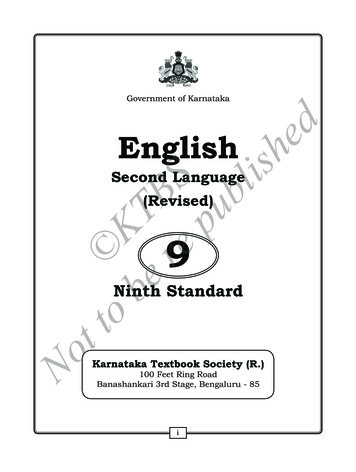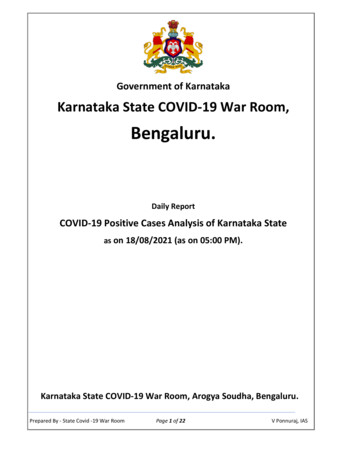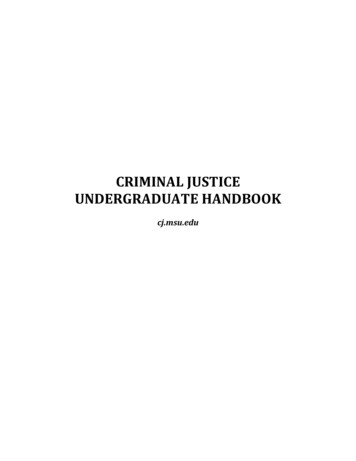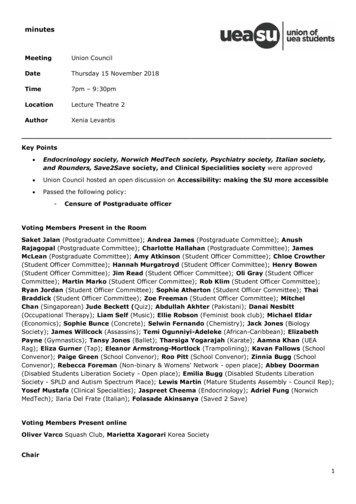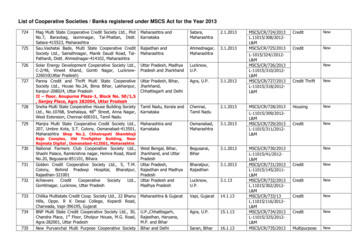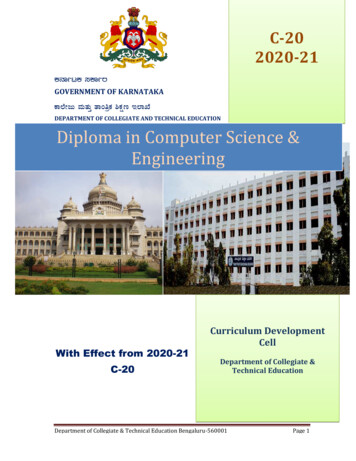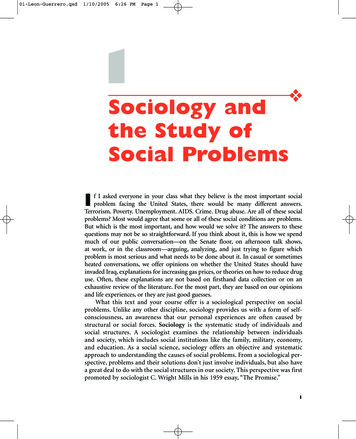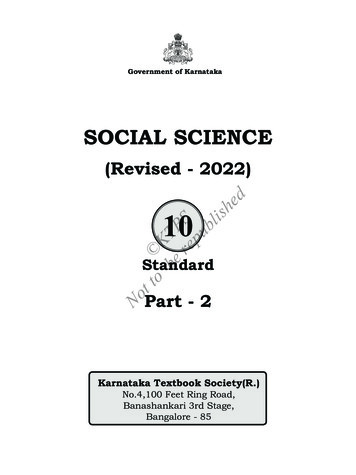
Transcription
Government of KarnatakaSOCIAL SCIENCEbe KTBre Spublished(Revised - 2022) 10NottoStandardPart - 2Karnataka Textbook Society(R.)No.4,100 Feet Ring Road,Banashankari 3rd Stage,Bangalore - 85
ContentChapterNo.ChaptersPage.NoHISTORY17THE FIRST WAR OF INDIAN INDEPENDENCE (1857)118THE FREEDOM STRUGGLE619INDIA AFTER INDEPENDENCE2920WORLD WARS AND INDIA’S ROLE34be KTBre SpublishedPOLITICAL SCIENCE21WORLD CHALLENGES AND INDIA’S ROLE4422WORLD ORGANISATIONS49SOCIOLOGYCOLLECTIVE BEHAVIOUR AND PROTESTS5924SOCIAL CHALLENGES65 23NottoGEOGRAPHY25INDIA - LAND USE AND AGRICULTURE7526INDIA - MINERAL AND POWER RESOURCES8527INDIA - TRANSPORT AND COMMUNICATION9228INDIA - MAJOR INDUSTRIES10029INDIA - NATURAL DISASTERS106ECONOMICS30RURAL DEVELOPMENT11331PUBLIC FINANCE AND BUDGET120BUSINESS STUDIES32ENTREPRENEURSHIP13033CONSUMER EDUCATION AND PROTECTION137ii
HISTORYChapter - 17THE FIRST WAR OFINDIAN INDEPENDENCE (1857)We learn about the following in this chapter:Causes for the First War of IndependenceImmediate causes for the revoltSpread of the revolt and its natureFailure of the revolt and its effectsbe KTBre SpublishedWith the objective of expanding their rule in India, the British hadbrought into force the Doctrine of Subsidiary Alliance and Doctrine ofLapse. Many provinces came into the control of the British because ofthese rules. As a result, Indians were upset. They were dissatisfied with theBritish administration too. This dissatisfaction surfaced as a major revoltin 1857. While some Indians called this ‘The First War of Independence’,British historians called it as ‘The Sepoy Mutiny’. Causes for the First War of Independence:NottoPolitical causes: Many kingdoms lost theirrights due to the promulgation of Doctrine ofLapse brought about by the British. Satara,Jaipur, Jhansi, Udaipur and other kingdomscame under British control. Dalhousiecancelled the princely titles of the Nawabs ofTanjore and Carnatic kingdoms. The Moghulsultans, the Nawab of Oudh and other kingswere stripped of their kingly status.Consequently, lakhs of soldiers who weredependent on these kings, became unemployed.This became a strong cause for the protest of1857 against the British.Do you know this:Doctrine of Lapse :Doctrine of Lapse: Thispolicy was establishedby Lord Dalhousie duringBritish rule. Accordingto this policy, an Indianking could not transfer hiskingdom to his adoptedchildren in the absence ofnatural heirs. Thus, hiskingdom came naturallyunder British rule.Economic causes: Due to the industrial revolution in England, Indianhandicrafts and cottage industries suffered heavily. England, instead of1
being a trading country, became a hub of industries. The Indian craftsmenbecame unemployed. Primarily, the textile and wool industries becamesick and people lost their jobs. The cottage industries too suffered adeath blow. The British imposed a heavy tax on sale of Indian goodsin England. Because of the zamindari system, the landlords, acting ascommission agents between the Government and the farmers, exploitedthe farmers. The right given to the taluks to collect tax was withdrawn. An‘Inam Commission’ was appointed and all the gifted lands (‘Inam lands’)were taken back. Due to this, the farmers felt insulted and experiencedmany financial problems. This too led to the revolt of farmers against thegovernment.be KTBre SpublishedAdministrative causes: The British brought into force new civil andcriminal laws. These were applicable only to Indians. English became thelanguage of the courts. Most of the time the British judges favoured theBritish. The new rules were not understood by the common people. Military causes: The condition of the Indian soldiers in the British armywas pathetic. The status, salary and opportunities for promotion thatBritish soldiers enjoyed were not given to Indian soldiers. The religioussentiments of the Indian soldiers were disturbed when they were forcedto cross the oceans to serve on a foreign land.NottoEruption of the Revolt and its spread:Most of the Indian soldiers in the British army believed that if theyfought together, they could drive away the British from India. At that time,the soldiers were being given new rifles called ‘Royal Enfield’. A rumourspread among the soldiers that the cartridges used in these rifles weregreased with the fat of cow and pigs. While cows were sacred to the Hindus,pigs were blasphemous for Muslims. This incident became the immediatecause for the revolt.The rumour that spread in the army troops at Barackpur led to severedissatisfaction. When the British officers ordered the Indian soldiers topull the safety catch with the help of their teeth, the soldiers rejected thecommand and revolted against their superiors. At this juncture, an Indiansoldier named Mangal Pandey killed a British official. Subsequently, hewas arrested, tried and hanged.2
Meerut was a strong military base of the British. When the Britishordered the Indian soldiers to use the greased cartridges, the soldiersrefused to carry out the order. The soldiers were imprisoned. As a result,there was a revolt in Meerut. Indian soldiers rushed into the prison andreleased the soldiers jailed there. This became the spark that led to thefire of the War of Independence. Later, the group of soldiers went to Delhifrom Meerut. They laid siege on the Red Fort and declared the Moghulking, Bahadur Shah II as the Emperor of India. Protesting soldiers fromdifferent parts of India reached Delhi. Consequently, theprotest became serious. It spread like wild fire to Kanpurand Jhansi.be KTBre SpublishedIn Kanpur, Nana Saheb rose in protest. Tatya Topewas his assistant. In Jhansi, a revolt took place underthe leadership of Queen Laxmibai. When Kanpur fell intothe hands of the British, Tatya Tope came to Jhansi tohelp the Queen.Thathya TopeNotto The heat of the revolt was felt in Lucknow too. Ultimately,Lucknow was taken over by the British. The war spreadto the south of river Yamuna. As a result, the soldiers inJhansi felt encouraged. Jhansi Rani Laxmibai who wasenraged by the Doctrine of Lapse, declared war against theBritish. She tied her adopted son to her back and foughtin the war. She took Gwalior under her control. When theJhansi Ranibattle took place again with the British, the Queen laidLaxmibaidown her life. Even today, the queen occupies a pride ofplace in the history of the independence struggle.Reasons for failure of the revolt:The First War of Independence of 1857 failed due to various reasons.The movement did not spread to the whole country. This struggle wasintended to protect the interests of a few rather than getting freedom forthe country. Instead of being an organized struggle, it erupted due tocertain unexpected reasons. The unity among the British forces and lackof it among the Indian soldiers also led to the failure. There was no properdirection or proper leadership. In addition, there was a lack of strategy,3
expertise among soldiers, effective leadership, discipline and direction.Many provincial kings, on account of their loyalty to the British, did notsupport the struggle. The people lost confidence in the soldiers due totheir arson and looting.Effects of the revolt:The freedom struggle put an end to the administration of the EastIndia Company, and the administration was taken over by to the Queenof England. The administrative responsibility was handed over to theSecretary of Indian Affairs in the British Parliament. In 1858, the Queenof England made a declaration. This declaration has been called India’s‘Magna Carta’. The following points were included in it: The agreements made by the East India Company with the kings wereaccepted.be KTBre Spublished Ambitious expansion plans had to be given up. A stable government had to be provided to Indians. There would be equality before law. The government would exhibit religious tolerance and not to interferein religious matters of the country.NottoThe British realized that peaceful rule was not possible withoutsupport, trust and confidence of the Indians. This gives new route toIndian freedom movement. Indians understood the inevitability of findingalternative routes to obtain freedom from the British.EXERCISESIFill in the blanks with suitable words:1. British historians refer to the 1857 revolt as .2. The policy brought into force by Dalhousie was .3. killed the British Major during the 1857 revolt.4. Jhansi Rani fought aganist British and took under hercontrol.4
IIDiscuss the following in groups and answer them:1. What were the effects of the Doctrine of Lapse? Analyse.2. The economic changes of the time were responsible for the 1857revolt. How?3. What were the factors that disturbed the religious sentiments ofthe soldiers during the 1857 revolt?4. What were the immediate causes for the First War of Independence?5. Make a list of the reasons for the failure of the revolt.6. What were the features of the declaration of the British Queen in1858?III Activities:be KTBre Spublished1. On the Indian map, mark the kingdoms which were taken over bythe British with the help of the Doctrine of Lapse.2. Organise a debate on “The 1857 revolt was the First War ofIndependence”.Notto 5
Chapter - 18THE FREEDOM STRUGGLEWe learn about the following in this chapter:be KTBre Spublished Indian National Congress Moderates, Extremists and Revolutionaries Non-cooperation Movement, Civil Disobedience Movement,Quit India movement Farmers’ and workers’ protests Subhash Chandra Bose, Dr.B.R.Ambedkar, Jawaharlal Nehruand Mohammad Ali Jinnah Partition of IndiaNotto There were many instances of protest against the establishment ofBritish rule in India. The wars fought by many kings against the Britishwere all in their own self-interest. After the First War of Independence in1857, many changes and effective reforms were brought in. Improvements intransport and communication, journalism, establishment of organizations,and changes in administration saw people getting engaged in huge numbersin many provinces. Lord Lytton brought in ‘Domestic Papers Control Act’in 1878 to exercise control over the Indian publications, and Lord Ripponbrought in ‘Ilbert Bill’ to bring in uniformity in the judicial system. Certainorganizations tried to protest against this in Europe and were successful.The freedom struggle assumed a specific direction as a result of protestsall over the country. To avoid armed struggle, the British adopted certainstrategies. Consequently, the British Government declared the supremacyof the Queen in 1858, and announced that Indians were British citizens.Through this step, the British government declared provision of betteramenities to Indians. In the subsequent developments, the aristocraticnew generation who learnt English, started fighting for their rights in aconstitutional manner. This led to the establishment of Indian NationalCongress.Indian National CongressRight from the time of Raja Ram Mohan Roy, the minds of middle classpeople of India were getting prepared to face new challenges. Towards this6
end, many organizations were established throughout the country. Amongthem, ‘The Hindu Mela’, ‘The East India Association’, ‘Poona SarvajanikSabha’ and ‘The Indian Association’ were prominent. They had limitedscope and interests. They were waiting for a national level integration tohappen at an appropriate time. An opportunity came handy for organizingsuch an all Indian organization. In the year 1885, a retired English officer,A.O.Hume established the Indian National Congress. It worked towardscreating political awareness and nationalist attitude.be KTBre SpublishedIn spite of the diversity in India, the Indian National Congress struggledto kindle the patriotic feelings of Indians. It published papers in the locallanguages and started debates on political problems. As a result, thepeople became aware of the political situation and its problems. The Britishrealized the growing strength of the Congress and started implementingits ‘Divide and Rule’ policy. They separated Hindus and Muslims throughtheir manipulative techniques. In spite of this, the Indian National Congresswas able to formulate positive plans of action related to national issues. By the end of the 19th century, differences surfaced in the IndianNational Congress. Based on the plan of action, beliefs and type of struggleadopted by them, they were identified as moderates and extremists.NottoFirst Phase : Moderates (1885 - 1906)Traditionally, the first 20 years of thebeginning of Congress are called the‘Moderate Age’. Among the moderates,M.G.Ranade, Surendranath Bannerjee,Dadabhai Naoroji and GopalakrishnaGokhale were prominent. The moderatestrusted the British administration andGopalakrishnaDadabhaitheir impartiality. They used to place theirGokhaleNaorojirequests and appeals before the governmentwithin the constitutional framework. The moderates taught people aboutpolitical situations. They conducted meetings, discussed problems andplaced before the government various requests related to development ofindustries, reduction of military expenses, improvement in educationalstandards, forcing the British government to take up studies about povertyin the country etc.7
For the first time, the moderates criticallyActivity :analysed the ill-effects of the British rule in India. Collect the photographsThey placed before the people facts and figures of moderates and readabout the drain of Indian wealth into England. their Biographies.Dadabhai Naoroji explained about the transfer ofIndian wealth to England and called it as Drain Theory. He maintainedthat encouraging imports and reducing exports created a situationunfavorable to India, leading to drain of wealth. Since India had to bearthe burden of paying wages, pension and administrative expenses of Britishofficials, a lot of wealth was flowing into England. The Age of Moderatesis also called the Age of Generous Nationalism.Second Phase : Extremists (1906 - 1920)Notto be KTBre SpublishedOne group of Congress members who became unhappy with themild attitude of the moderates called them ‘political beggars’. Those whocriticized the moderate thinking and propagated extremist ideas wereknown as Extremists. Aurobindo Ghosh, Lala Lajpat Rai, Bipin ChandraPal and Balgangadhara Tilak were the prominent extremist leaders.AurobindoGhoshBalgangadharaTilakLala LajpatRaiBipin ChandraPalPartition of Bengal: Bengal was the centre of protests and anti-Britishsentiments. In order to curb this, Viceroy Lord Curzon proposed a planto divide Bengal citing administrative problems. East and West Bengalbased on Muslim and Hindu population were created. Thus, by creatingdifferences between the two communities, they tried to reduce the intensityof freedom struggle.Extremists opposed the partition of Bengal in the year 1905, highlightingit as an example of ‘Divide and Rule’ policy. Protests started mountingthroughout the country against the division of Bengal. The Swadeshimovement was very important among these protests. Swadeshi movement8
called for a ban on western goods and the organizations supporting theimport of European items. They encouraged the people to use Indian goods.In the backdrop of these explosive protests, in 1911 the British governmentwithdrew the Declaration of Partition of Bengal.Do you know this?be KTBre SpublishedExtremists maintained that good Do you know this?administration cannot be a substitute forTilak inspired nationalismindependence. Tilak declared: “Swaraj is my in people through Ganeshabirthright and I will get it at any cost”. Thus, festival and Shivaji birthdayan independent India was the aim of celebrations.extremists. They started preparing thecommon people for freedom struggle. Throughreligious functions they started organizing people for a freedom movement.Lokamanya Tilak utilized his ‘Kesari’ in Marathi and ‘Maratha’ newspaperin English for freedom struggle. Through these papers he called for theactive participation in the fight for freedom. He was imprisoned for hisrevolutionary articles and enquiries were instituted against him. He wroteGeetha Rahasya in the jail.Notto “In the development of a nation, inefficient administrators fulfil certainuseful objectives: they bring to wakefulness the lion sleeping carelessly;they are helpful in bringing about national integrity through inspiringpeople.” These words of S.N.Bannerjee can apply to the revolutionarieswho fought for our freedom.The role of Revolutionaries in freedom struggle :The revolutionaries dreamt of a totally free India. They strongly believedthat the British could be thrown out of India only by violent means. Theystarted establishing their secret branches in India and abroad, and engagedin collection of money, arms and training of people. ‘Anusheelana Samithi’and ‘Abhinava Bharata’ were important organizations of this kind. Theyused bombs and firearms to achieve their objectives. The government triedtheir best to suppress them. The revolutionaries were arrested for murderattempts. They were declared guilty and given life imprisonment. Many werehanged to death. V.D.Savarkar, Aurobindo Ghosh, Shyam KrishnaVerma,Ras Bihari Ghose, Madame Cama, Khudiram Bose, Ramaprasad Bismil,Bhagat Singh and Chandrashekar Azad were prominent revolutionaryleaders.9
The dream of the revolutionaries of gaining independence throughforceful means did not succeed. However, they were a powerful source ofinspiration for the national freedom movement. Some of the extremistsin the later years continued their struggle as revolutionaries. Prominentamong them was Aurobindo Ghosh.ChandrashekarAzadV.D. Savarkarbe KTBre SpublishedBhagat SinghNotto Gaidin Liu : The christian missionary and the power of the Britishwas taking control of the whole of north-east India. Knowing about this,Jadonang of the Naga tribe, an youngster built a youth's army to fightagainst the British. But there was no place for the ladies. So Gaidin Liu,an young lady collected ladies of North-eastern India and joined Jadonangto fight the British. She joined the Herakka religious movement along withJadonang. British Government Imprisoned Jadonang at silcher jail andlater hanged him to death on 29th August 1931. Gaidin Liu took chargeof the army and let the movement against the British. In just 8 monthsthe British were taken aback. She fought on the lines of Guerilla warfare.The entire villages of North-east co-operated. Thousands of people joinedher army. Some of the traitors gaveinformation about her to the British. Do you know this?Aurobindo Ghosh published aMacdonald who was against her gotinformation from doctor Haralu and book ‘Vartaman Rananiti’ in whichhe proposed military training andImprisoned her. She was in jail fromskills of warfare. Even Barinder1932 Oct 12th till India became free.Kumar Ghosh expressed the sameHaralu was awarded with Kaiser - Eviews in his daily ‘Yugantar’.- Hind by the British.10
Final Phase : Gandhian era. (1920 – 1947)Do you know this?Notto be KTBre SpublishedGandhiji got his Barrister degree in England andstarted his law practice in South Africa. The Britishwho were ruling South Africa, practised apartheidand discriminated mainly against Africans andIndians. People who were employed in low-paid jobs,were not allowed to travel on trains along with thewhite people and could not eat along with them. TheBritish treated them mercilessly. Gandhiji broughttogether the people who were discriminated against, Gandhiji in South Africaand carried out agitations and protests against theBritish in a peaceful, non-violent manner. The success that he got to hismovement against the British in South Africa inspired Gandhiji to do thesame in India and achieve freedom from the British.In the freedom movement of India, 1920-1947 is also termed GandhianAge. Gandhiji was in the forefront of the struggle till India won herindependence. With the entry of Gandhiji, the freedom movement gained anew dimension. Gandhiji made use of indirect protests, non-violence andsatyagraha as the main instruments for the freedom struggle. He wroteabout his principles in the newspaper ‘Young India’. Satyagraha was hismain political weapon.Satyagraha:Gandhiji succeeded in using satyagraha to fight against the apartheidpolicy in Africa. He used the same weapon in the Indian freedom struggle.He maintained that satyagraha was not a way to apply physical pressure onanyone but a struggle accompanied by self-respect.Do you know this?With the entry of Gandhiji, admission to the Congress was made open toeveryone and it became the common man’s organization. In order to press forfulfillment of its demands, the organization resorted to non-cooperation andcivil dis-obedience movement. It also suggested positive programmes for theupliftment of the society. To implement their plans, the Congress began the‘Tilak Swarajya Fund’ with an investment of one crore rupees. In this manner, acomplete change could be witnessed in the Congress with the arrival of Gandhijiin the organization. Hence, this period has been called ‘Gandhian age’.11
The British government brought into force many regulations with a viewto suppress the increasing revolutionary activities. The most important ofthem was the Rowlatt Act in 1919, which gave the judges power to arrestand interrogate people based on mere suspicion. Gandhiji protested againstthis inhuman Act through satyagraha. It gained support throughout thenation. Thousands of Indians participated in these protests against theBritish.Jallianwallah Bagh Massacre: be KTBre SpublishedPunjab witnessed widespread protests against Rowlatt act. As theprotests turned violent, the control over Amritsar city was given to GeneralDyer. Dyer imposed military rule in the city and banned all demonstrationsagainst the british rule. The protestors had decided to assemble atJallianwallah Bagh. They were not aware of this ban. About 20,000protestors had assembled in this demonstration against the Rowlatt act.This peaceful demonstration was in progress in high-walled JallianwallahBagh which had narrow entrances. General Dyer arrived at this placewithout any previous warning with his army, and attacked the protestorsfrom all sides with firearms. In this massacre, about 379 people died andthousands suffered serious injuries. This incident is called JallianwallahBagh tragedy.NottoThe government appointed Hunter Commission to conduct an enquiryinto the Jallianwallah Bagh tragedy, but it was of no consequence. Theatrocities against Indians continued.Do you know this?In the backdrop of JallianwallahBagh tragedy, Rabindranath Tagorewrote a letter to the Viceroy andsurrendered the ‘Knighthood’ awardedto him. The revolutionary UdhamSingh killed General Dyer who hadmassacred innocent Indians.12
Khilafat MovementThe British had plans to demolish the Ottoman Empire during the IWorld War. The Turkish Emperors of the Ottoman Empire were MuslimKhalifs. Due to this, the hatred against the British grew in the minds ofIndian Muslims. Ali brothers started the Khilafat movement in India in orderto support the Turks. Gandhiji believed that only if Hindus and Muslimsfought together against the British, the British would leave the country.In this context, he felt that participation of Muslims in the Congress wasvital. Hence, Gandhiji declared his support to the Khilafat movement. Thisturned out to be a joint Hindu-Muslim nation-wide movement against theBritish. Many national leaders and the Congress took active part in theKhilafat movement.Non-co-operation movement be KTBre SpublishedIn the year 1920, Gandhiji gave a call for a non-co-operation movementagainst the British. Students supported his call by abstaining from schoolsand colleges. Lawyers remained away from courts. Indian dignitariesreturned all the awards given by the British. Supporting this movement,Motilal Nehru and C.R.Das sacrificed their law careers. During this period,there was a stiff opposition to the visit of the British Prince. There werewidespread agitations against the visit throughout the country.NottoAfter seeing the intensity of the agitation, fear surfaced in the mind ofthe British. At this juncture, thousands of people jumped into the freedomstruggle at Chowri-Chowra inUttar Pradesh. In the year 1922,police used their force againstpeaceful protestors. Enragedby this, the people tried toenter the police stations. Policeresorted to firing. When theirammunition got exhausted, thepolice ran into the station. Theangry protestors set the policestation on fire. About 22 policewere burnt alive inside theNon-co-opration movementstation. This incident is termed13
Chowri-Chowra incident in history. The incident made Gandhiji unhappy.Gandhiji resented the violent incident and withdrew his non-co-operationmovement. The British government considered Gandhiji responsible forthe violent event. It sentenced him to prison for six years. But in 1924,Gandhiji was released citing the reason of ill-health.Do you know this?In the corporation elections that took place in Calcutta in 1924,Swaraj Party won the majority. C.R.Das was elected as the Mayor.He was known as ‘Deshbandhu’.Notto be KTBre SpublishedThrough the 1919 Act, Indians were given theopportunity to contest elections. However, since theatrocities and injustice by the British were continuing,some Congressmen rejected the Act. With an intentionof contesting elections in the future, Motilal Nehru andC.R.Das, along with some other Congressmen, established‘Swaraj Party’ in 1923. Through this party, they wantedto enter the legislative assembly and oppose the policies Motilal Nehruof the British from within. In the subsequent BelgaumConference held in 1924, Gandhiji approved of the plan of the SwarajParty and accepted it as a part of the Congress plan. Thus Swaraj Partybecame a part of the Congress.According to the Government of India Act of 1919, there was a proposalto appoint a Commission at the end of ten years. This Commission was toexamine the impact of the 1919 Act, suggest suitable changes if needed, andsubmit it to the government. Accordingly, in 1927, the British Governmentappointed the Simon Commission under the leadership of John Simon.This commission did not have a single Indian as the member. Treating it asan insult to India, the Congress boycotted the Simon Commission. Therewere widespread demonstrations during the visit of Simon to India. Thepeople started shouting ‘Simon, Go back’. Wherever the Simon Commissionwent, it witnessed demonstrations, hartals and agitations. During thistime, Lala Lajpat Rai who was the leader of the movement, died after beinginjured in police caning. This made the Indians’ fight much more intense.14
Do you know this : On January 1st, 1930, Jawaharlal Nehruhoisted the Indian tri-colour on the banks of river Ravi.With an intention to reduce the hatred towards the government, assoon as the Commission’s work was over, the British government decidedto call a meeting of the Indian representatives and have a discussion withthem. The result was the Round Table Conference.In the year 1929, under the presidentship of Jawaharlal Nehru, aCongress Session was held in Lahore. During this conference, the Congressdeclared that ‘Purna Swaraj’ was their aim. On January 26, 1930, theCongress celebrated Independence day all over the country and supportedthe Lahore declaration. This conference entrusted the responsibility oforganizing the ‘Civil Disobedience’ movement to Gandhiji.be KTBre SpublishedCivil Disobedience MovementNotto Gandhiji, after assuming theleadership of Civil disobediencemovement, submitted a Charter of11 demands to Viceroy Irwin. He hadconveyed that if these demands were notmet, he would start Civil Disobediencemovement. One of the demands wasabolition of tax imposed on salt. But IrwinDandi Marchdid not consider Gandhiji’s demands.As a result, in the year 1930, Gandhijitravelled from Sabarmati Ashram to Dandi in Surat on foot with hisfollowers to produce salt in the seashore. In this manner, he started theCivil Disobedience Movement. This event in history is popular as ‘DandiMarch’.Vijayalakshmi Pandit, Kamala Nehru, Vallabhai Patel, Rajagopalachari,Babu Rajendra Prasad and thousands of others who participated in theCivil Disobedience movement were arrested. This agitation spread to manyparts of the country.15
Do you know this? In the Dandi march, Karnataka’s 18-year old Mylara Mahadevappa alsoparticipated. Karnataka Congress formed a committee with R.R.Diwakar, KoujalgiHanumantharao, Gangadhar Deshpande Hardikar and Karnad SadashivaRao and started the production of salt at Ankola taluk in Karwar district.Notto be KTBre SpublishedAs mentioned earlier, as per the decision of the British governmentto call a meeting of the Indian representatives, the First Round TableConference was held in 1930. The result was that the British understoodthey could not take any decision without the participation of Indian leaders.In this conference, an opportunity was created to allow untouchablesto be represented separately. In order to enable them to participate inthe conference, Gandhiji and other Congress leaders were released fromprison. But Gandhiji and the Congress refused to attend the conference.Representatives of the princely kingdoms, leaders of different communitieslike B.R.Ambedkar, M.R.Jayakar, Tej Bahadur Sapra, Mohammad AliJinnah, Srinivas Shastri and others took part in the conference. Approvalwas given to matters like Dominion status, responsible government andcasteist representation at the conference. But since the Congress did notparticipate there, the conference was not productive. In order to bring theIndian National Congress to the conference and help Britain achieve itsobjectives, Viceroy Irwin met Gandhiji and discussed certain proposals.The result of this discussion was the Gandhiji-Irwin Pact in 1931. In thesubsequent developments, the Congress gave up its C
social movements 62 4. social problems 72 geography 8. india - mineral and power resources 87 9. india - transport and communication 96 10. india - industries 106 11. india - natural disasters 113 12. india - population 120 economics 3. money and credit 125 4. public finance and budget 133 business
